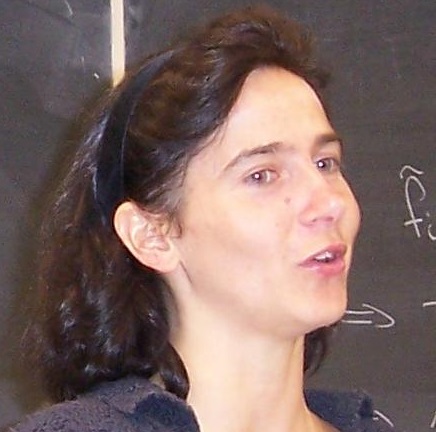4.1: Definition of vector spaces
( \newcommand{\kernel}{\mathrm{null}\,}\)
As we have seen in Chapter 1 a vector space is a set V with two operations defined upon it: addition of vectors and multiplication by scalars. These operations must satisfy certain properties, which we are about to discuss in more detail. The scalars are taken from a field F, where for the remainder of these notes F stands either for the real numbers R or for the complex numbers C. The sets R and C are examples of fields. The abstract definition of a field along with further examples can be found in Appendix C.
Vector addition can be thought of as a function +:V×V→V that maps two vectors u,v∈V to their sum u+v∈V. Scalar multiplication can similarly be described as a function F×V→V that maps a scalar a∈F and a vector v∈V to a new vector av∈V. (More information on these kinds of functions, also known as binary operations, can be found in Appendix C. It is when we place the right conditions on these operations that we turn V into a vector space.
Definition 4.1.1. A vector space over F is a set V together with the operations of addition V×V→V and scalar multiplication F×V→V satisfying each of the following properties.
- Commutativity: u+v=v+u for all u,v∈V;
- Associativity: (u+v)+w=u+(v+w) and (ab)v=a(bv) for all u,v,w∈V and a,b∈F;
- Additive identity: There exists an element 0∈V such that 0+v=v for all v∈V;
- Additive inverse: For every v∈V, there exists an element w∈V such that v+w=0;
- Multiplicative identity: 1v=v for all v∈V;
- Distributivity: a(u+v)=au+av and (a+b)u=au+bu for all u,v∈V and a,b∈F.
A vector space over R is usually called a real vector space, and a vector space over C is similarly called a complex vector space. The elements v∈V of a vector space are called vectors.
Even though Definition 4.1.1 may appear to be an extremely abstract definition, vector spaces are fundamental objects in mathematics because there are countless examples of them. You should expect to see many examples of vector spaces throughout your mathematical life.
Example 4.1.2. Consider the set Fn of all n-tuples with elements in F. This is a vector space with addition and scalar multiplication defined componentwise. That is, for u=(u1,u2,…,un),v=(v1,v2,…,vn)∈Fn and a∈F, we define
u+v=(u1+v1,u2+v2,…,un+vn),au=(au1,au2,…,aun).
It is easy to check that each property of Definition 4.1.1 is satisfied. In particular, the additive identity 0=(0,0,…,0), and the additive inverse of u is −u=(−u1,−u2,…,−un).
An important case of Example 4.1.2 is Rn, especially when n=2 or n=3. We have already seen in Chapter 1 that there is a geometric interpretation for elements of R2 and R3 as points in the Euclidean plane and Euclidean space, respectively.
Example 4.1.3. Let F∞ be the set of all sequences over F, i.e.,
F∞={(u1,u2,…)∣uj∈F for j={1,2,…}}.
Addition and scalar multiplication are defined as expected, namely,
(u1,u2,…)+(v1,v2,…)=(u1+v1,u2+v2,…),a(u1,u2,…)=(au1,au2,…).
You should verify that F∞ becomes a vector space under these operations.
Example 4.1.4. Verify that V={0} is a vector space! (Here, 0 denotes the zero vector in any vector space.)
Example 4.1.5. Let F[z] be the set of all polynomial functions p:F→F with coefficients in F. As discussed in Chapter 3, p(z) is a polynomial if there exist a0,a1,…,an∈F such that
p(z)=anzn+an−1zn−1+⋯+a1z+a0.
Addition and scalar multiplication on F[z] are defined pointwise as
(p+q)(z)=p(z)+q(z),(ap)(z)=ap(z),
where p,q∈F[z] and a∈F. For example, if p(z)=5z+1 and q(z)=2z2+z+1, then (p+q)(z)=2z2+6z+2 and (2p)(z)=10z+2.
It can be easily verified that, under these operations, F[z] forms a vector space over F. The additive identity in this case is the zero polynomial, for which all coefficients are equal to zero, and the additive inverse of p(z) in Equation (4.1.1) is −p(z)=−anzn−an−1zn−1−⋯−a1z−a0.
Example 4.1.6. Extending Example 4.1.5, let D⊂R be a subset of R, and let C(D) denote the set of all continuous functions with domain D and codomain R. Then, under the same operations of pointwise addition and scalar multiplication, one can show that C(D)also forms a vector space.
Contributors
- Isaiah Lankham, Mathematics Department at UC Davis
- Bruno Nachtergaele, Mathematics Department at UC Davis
- Anne Schilling, Mathematics Department at UC Davis
Both hardbound and softbound versions of this textbook are available online at WorldScientific.com.


